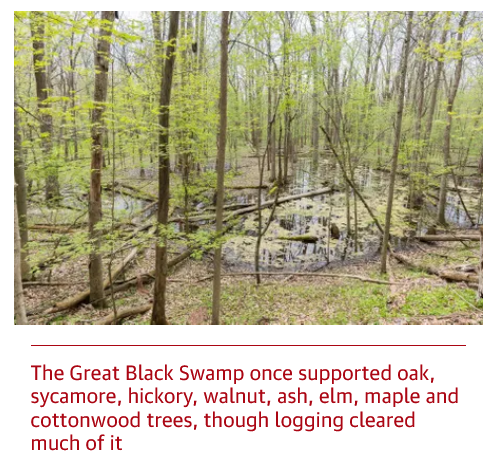#go check out the distribution map for the Kirtlands snake and see how it also is endemic to limited wetlands in Illinois Indiana and Ohio
Text



At the intersection of Ohio, Michigan and Indiana, the corn monoculture melts away to reveal green rolling hills and deep gorges. The lush forest is pockmarked by steep-banked ponds, carved out by retreating glaciers 10,000 years ago. Standing waist-deep in a forest pool, Megan Seymour scans the shrubby banks with binoculars. A slight change in colour and texture spotted in the tangled buttonbush swamp reveals her quarry: a thick, glossy, copperbelly water snake (Nerodia erythrogaster neglecta). [...]
The copperbelly water snake – named for its tangerine-orange underside – inhabited what was one of the largest wetland areas in North America.
Roughly the size of Connecticut and stretching from Fort Wayne in Indiana across much of north-west Ohio, the Great Black Swamp was home to elk, wolves, mountain lions and black bears.
In the mid-19th century, farmers began to clear the trees and drain the swamp to access the fertile soil hidden beneath the water. In just five decades, the Great Black Swamp was dry.
Today, the copperbelly water snake lays claim to just 50 sq km (20 sq miles) of remnant swamp forest in the tri-state area – slightly smaller than Manhattan Island.
Though the exact number of the reptiles is not known, experts estimate that fewer than 100 individuals, possibly as few as 40, remain.
“I think they will be gone within 20 years,” says [...] a land steward with the Nature Conservancy [...]. He believes saving the copperbelly water snake is essential to the region’s ecology because it is “an umbrella species” [...] for dozens of other declining species that rely on the swamp forest, including the rare bobolink blackbird and the checkerspot butterfly. When Seymour began searching for copperbelly water snakes in spring 2021, no one had seen one alive in the wild in almost three years. She spent more than 180 hours combing through the wetlands historically inhabited by the species but found none. [...]
---
All content above, images, caption, and text published by: Ryan Wagner. “‘They aren’t mean and they aren’t trying to get you’: saving the copperbelly water snake.” The Guardian. 14 February 2023. [All photos published with this story were also taken by Ryan Wagner. Bold emphasis and some paragraph breaks added by me.]
For reference, here’s the distribution range of the copperbelly water snake:

And here, what was once the Great Black Swamp:

Snake, endemic species unique to Great Lakes region and flooded prairies of the “Prairie Peninsula,” nearly extinct.
#extinction#endemic species#great lakes#prairie#go check out the distribution map for the Kirtlands snake and see how it also is endemic to limited wetlands in Illinois Indiana and Ohio#Kirtlands snake is a crayfish specialist that lives in crustacean burrow systems in flooded prairies#also the eastern massasauga aka the miniature swamp rattlesnake also uses crayfish burrows and limited to wetlands of great lakes region
318 notes
·
View notes